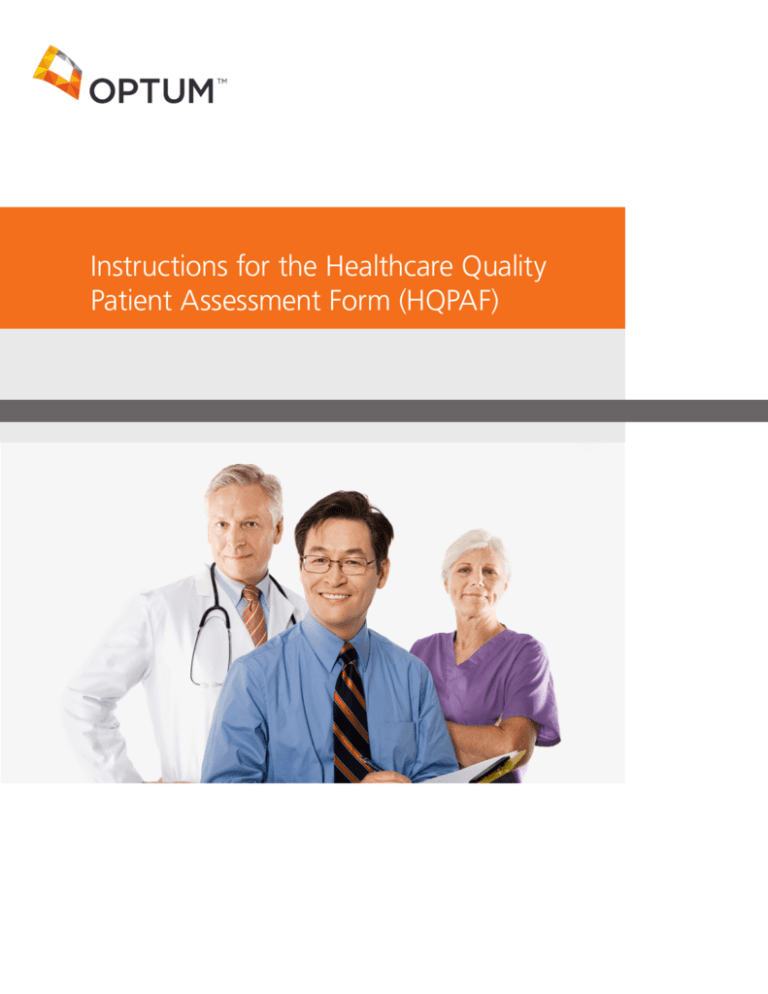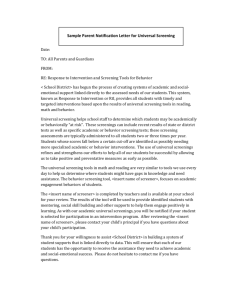
Instructions for the Healthcare Quality
Patient Assessment Form (HQPAF)
Provider Instructions
The Healthcare Quality Patient Assessment Form (HQPAF) program promotes early detection and ongoing assessment
of chronic conditions for our clients’ Medicare Advantage and Medicaid Managed Care Plan members. The goal of the
HQPAF program is to help ensure that these patients receive a complete and comprehensive annual assessment.
Instructions for Completing the HQPAF
1
Schedule an annual assessment for the patient listed on the HQPAF or review the document during the patient’s next office
visit. Complete and return the first page of the HQPAF along with supporting medical record documentation. It is important
that you utilize your patient’s HQPAF during the point of care. On some forms, patient information may extend to the second
page. In these instances, you must complete and return both the first page and the second page. Note: Certain types of
procedures, including screenings and labs, may result in out-of-pocket expenses for the patient, depending on health plan
benefits.
2
Document in the progress note, including clear provider signature & credential(s), patient name, and date of service. Results,
referrals and any applicable exclusions must be documented in progress notes and returned with the HQPAF. Note: Each
form must be returned within a certain time frame. Check the HQPAF for the eligible dates of service for submission. Some
HEDIS screenings may occur outside the eligible dates of service
3
Submit the applicable pages of the form and progress note(s) to support all chronic conditions and co-morbid factors,
documented to the highest level of specificity. Submission options:
Secure Fax Server: 1-877-889-5747 or
Traceable Carrier:
Optum - Attn. Prospective Programs Processing - 7105 Moores Lane - Brentwood, TN 37027
Early Detection of Chronic Illnesses
The Early Detection of Chronic Illness section provides recommendations for screenings for chronic illness(es) based on
previously reported risk factors and/or co-morbid conditions. Provider should consider screening for the listed conditions and
confirm in progress notes.
Preventive Medicine Screening
The Preventive Medicine Screening section is populated based on HEDIS (Healthcare Effectiveness Data and Information Set)*
specifications. Screenings are included if data indicates that screenings are either due or overdue for the patient. Results,
referrals and exclusions must be documented in progress notes and returned with HQPAF.
Screening
Criteria for Inclusion
Breast Cancer Screening
Screening is recommended for female patients age 50 – 74 who have not had a
mammogram in the 27 months prior to 12/31 of the current year.
Colorectal Cancer Screening
Screening is recommended for patients age 50-75, who have not had any of the
following:
• FOBT in the current calendar year
• Flexible Sigmoidoscopy in the current or 4 previous calendar years
• Colonoscopy in the last 10 calendar years
Cardiovascular Care –
Cholesterol Screening
Screening is recommended for patients discharged alive for AMI, CABG, or PCI from
01/01 - 11/01 of prior year or who had diagnosis of IVD during current or prior calendar
year. LDL-C control is < 100 mg/dL
Glaucoma Screening
Screening is recommended for patients over 67, who have not had a glaucoma screening
by an optometrist or an ophthalmologist in the current or previous calendar year
Adult Body Mass Index (BMI)
Screening is recommended for all patients age 18-74. Documentation in the medical
record must indicate the weight and BMI value, dated during the measurement year or
year prior to the measurement year.
* HEDIS® is a registered tradmark of the National Committee for Quality Assurance (NCQA). Additional information can be found at: www.ncqa.org
Provider Instructions
Care for Older Adults (This section applies to Special Needs Plans members only)
Measure
Suggested Action
HEDIS Specification
Advanced Care
Planning
Discussion with patient
Recommended during the calendar year for adults 66 years and older.
Evidence of advance care planning during the measurement year.
The advanced care plan or documentation of discussion with patient
(including date) should be included in medical record. Provider should
document in medical record if a member previously executed an
advanced care plan.
Medication
Review
Annual review of medications
Recommended that adults 66 years and older have an annual review all
medications (prescriptions, OTC, herbal/supplemental therapies)
Functional Status Assess activities of daily living
(ADL); instrumental activities
Assessment
daily living (IADL); other
standardized assessment
Recommended that adults 66 years and older have at least one
functional status assessment during the measurement year.
Assessments of ADL or IADL should be documented in medical
record. Examples of other standardized assessment includes: SF-36,
Assessment of Living Skills & Resources (ALSAR), Barthel ADL Index
Physical Self-Maintenance (ADLS) Scale, Bayer Activities of Daily Living
(B-ADL) Scale, Barthel Index). Notation that at least 3 of the following
4 were assessed is compliant: cognitive status, sensory ability (hearing,
vision, speech) or other functional independence (e.g. exercise, ability
to perform a job).
Comprehensive
Pain Screening
Recommended that adults 66 years and older have at least one
pain screening or pain management plan during the measurement
year. Documentation should include a quantification of pain and
determination of how it impacts everyday living. If applicable, describe
the pain management plan in the medical record.
Comprehensive pain
assessment and/or pain
management plan
Ongoing Assessment & Evaluation
The Ongoing Assessment section provides potential diagnosis information for the patient based on risk factors or comorbid
conditions. Providers should assess the patient to determine if the condition currently exists and send supporting documentation in
accompanying progress notes.
Managing Chronic Illness(es)
Conditions included in this section have been identified through claims data. Providers should complete the suggested actions
or send in medical record documentation that confirms the screening was already completed within the HEDIS specified
timeline.
Condition
Suggested Action
HEDIS Specification
Chronic Obstructive
Pulmonary Disease (COPD)
Spirometry Test
Patients 40 years and older with a new diagnosis of COPD or
newly active COPD should receive appropriate spirometry testing to
confirm the diagnosis (within 180 days of first COPD diagnosis)
Controlled Blood Pressure
Blood Pressure
Evaluation
Patients with diagnosis of high blood pressure who receive
treatment and are able to maintain a healthy pressure (<140/90)
during the calendar year
Diabetes Mellitus
Blood Pressure
Evaluation
BP tested at least annually and controlled to <(130/80) mm Hg
Nephropathy
Screening
Medical attention to nephropathy to occur annually, such as a urine
microalbumin test, referral to a nephrologist and/or an ACE/ARB
prescription. Screening is recommended for patients with diabetes,
age 18-75, who have not had a diabetic nephropathy screening
in the current calendar year. Patients seeing a nephrologist, or
currently diagnosed with nephropathy are excluded.
- continued on back cover -
Provider Instructions
Managing Chronic Illness(es) (continued)
Condition
Suggested Action
HEDIS Specification
Diabetes Mellitus
LDL-C Screening
Test is recommended for patients with diabetes, age 18-75, who
have not had an LDL cholesterol screening in the current calendar
year. LDL-C control is < 100 mg/dL
Diabetic Eye Exam
Exam is recommended for patients with diabetes, age 18-75,
who have not had a glaucoma screening by an optometrist or an
ophthalmologist in the current calendar year
HbA1c Testing
Test is recommended for patients with diabetes, age 18-75, who, in
the current calendar year:
• have an HbA1c result over 8% or
• have not had an HbA1c test
Stars measure defines HbA1c levels >9.0% as poorly controlled.
Osteoporosis Management Bone Density
Test (BDT) and/or
Prescription Treatment
BDT for females 65+ to check for osteoporosis. For those who
experience a fracture, BDT within 6 months or a prescription to
treat osteoporosis.
Rheumatoid Arthritis
Those diagnosed with rheumatoid arthritis to receive at least one
ambulatory prescription for a disease modifying anti-rheumatic
drug (DMARD) during the measurement year
Prescription Treatment
Medical History Reported to Health Plan
This section is to be retained for your records and is populated based on data received from all providers, including specialists
and pharmacies.
Screening
Criteria for Inclusion
Office Visits
A list of the providers the patient has seen at least twice over the course of the
previous 24 months is included (outpatient office visits only & some specialties
excluded)
Date of Last Annual Exam
Allows immediate identification of patients who are overdue for an annual exam
by providing the date of the patient’s last annual exam as well as the name of the
treating provider. Note: Annual Exam identified using Optum’s definition.
____/____/____
ER Visits
List of dates the patient visited an emergency room during the previous 24 months;
visit did not result in an admission
Hospitalizations
A history of hospitalizations the patient has had over the course of the previous 36
months
Three-Year Condition List
Provides a list of chronic and non-chronic conditions that have been submitted based
on claims for the patient within the previous three years. A legend is provided that
shows whether diagnosis came from inpatient, provider office or a combination of
provider types.
High-Risk Medications
A list of medications according to HEDIS that are considered to have a high risk of
serious side effects for patients 65 and older.* Please consider whether a safer drug
choice is available. Note that the medication list is limited to prescriptions filled using
health plan coverage; self-pay prescription data not available.
ACEI or ARB, Statins and Oral
Medications monitored for adherence will be flagged with “GAP” when two or more
Diabetes Medications - Monitored fill dates present and total “Days Supply” is less than 80% of the total days on the
medication type. Consider engaging patient to discuss barriers to taking medication
for Patient Adherence
as directed.
Diabetes Treatment
Alerts providers if patients who are both diabetic and hypertensive are missing an Rx
for either condition
Other Prescriptions
Any other prescription medications not in the aforementioned sections
*All HCCs listed reflect CMS HCC Model V22.
www.optum.com
13625 Technology Drive
Eden Prairie, MN 55344
This guidance is to be used for easy reference; however, the ICD-9-CM code book and the Official Guidelines for Coding and Reporting are the authoritative references for accurate and complete
coding. The information presented herein is for general informational purposes only. Neither Optum nor its affiliates warrant or represent that the information contained herein is complete,
accurate or free from defects. Specific documentation is reflective of the “thought process” of the provider when treating patients. All conditions affecting the care, treatment or management
of the patient should be documented with their status and treatment and coded to the highest level of specificity. Enhanced precision and accuracy in the codes selected is the ultimate goal.
Lastly, on April 7, 2014 CMS announced a revised CMS-HCC risk adjustment model that differs from the proposed Medicare risk adjustment model. For more information see: http://www.
cms.gov/Medicare/Health-Plans/MedicareAdvtgSpecRateStats/Downloads/Advance2015.pdf, http://www.cms.gov/Medicare/Health-Plans/MedicareAdvtgSpecRateStats/Downloads/
Announcement2015.pdf, and http://www.cms.gov/Medicare/Health-Plans/MedicareAdvtgSpecRateStats/index.html.
Optum and its respective marks, such as OptumInsight, are trademarks of Optum, Inc. Other brand or product names may be registered marks of their respective owners. As we are continuously
improving products and services, Optum reserves the right to change specifications without prior notice. Optum is an equal opportunity employer.
© 2014 Optum. All Rights Reserved • Revised 07/14/2014 • CP0062






